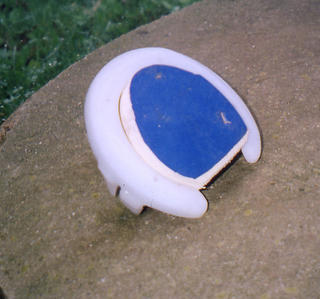 Big Brown's left front foot has a raceplate glued on with a PMMA epoxy type adhesive that is custom selected. The specs used are Lord 403 with a #19 accelerator. You can see a copper "clip" embedded in the glue; it is riveted to the shoe and is used only as a receptor for additional glue. The horse had wall separations on both front feet that required repair.
Big Brown's left front foot has a raceplate glued on with a PMMA epoxy type adhesive that is custom selected. The specs used are Lord 403 with a #19 accelerator. You can see a copper "clip" embedded in the glue; it is riveted to the shoe and is used only as a receptor for additional glue. The horse had wall separations on both front feet that required repair.
There has been some confusion and misinformation in the press so to clarify: the colt was originally worked on by Ian McKinlay in New York, and the horse benefited from his new Yasha shoe technology and heel resection technique. Ian has been supplying photos and videos of the technique and system.
But the horse subsequently was worked on by Tom Curl, an associate of Ian's. Tom did the work on the second foot.
What you see is a collaborative effort of two experts using a new technology that has been helping a lot of horses over the past few months.
 This is the bottom of the foot, showing the placement of the clips. The shoe has a rubber-like gasket rim pad on the inside that is half the web of the shoe. Adhesive is under the other half of the web. This is a unique modification of the "direct glue" technique used by farriers.
This is the bottom of the foot, showing the placement of the clips. The shoe has a rubber-like gasket rim pad on the inside that is half the web of the shoe. Adhesive is under the other half of the web. This is a unique modification of the "direct glue" technique used by farriers.
 This foot shows the repair situation on the inside heel of the first foot, which was done by McKinlay in New York. You can see that the new heel wall is growing down.
This foot shows the repair situation on the inside heel of the first foot, which was done by McKinlay in New York. You can see that the new heel wall is growing down.
 Here's the foot worked on in Florida by Curl, showing the heel repair on the right side of the photo. The glue on the left side is just for reinforcing the shoe.
Here's the foot worked on in Florida by Curl, showing the heel repair on the right side of the photo. The glue on the left side is just for reinforcing the shoe.
Tom said that he used more glue than McKinlay because he knows the Derby will fall three weeks after the horse was done, and the glue can be stressed over time, so he was pro-active.



